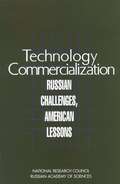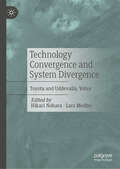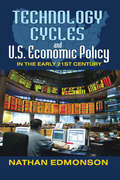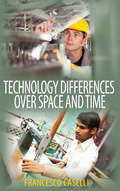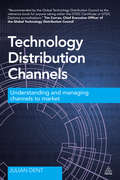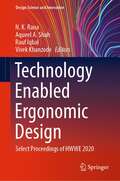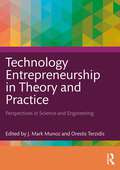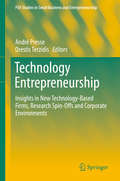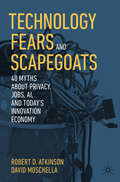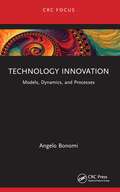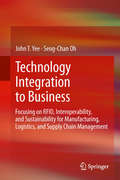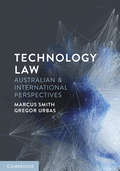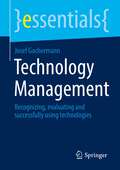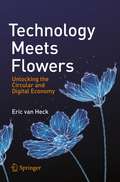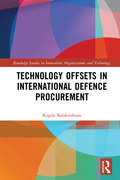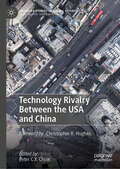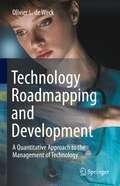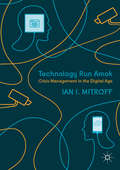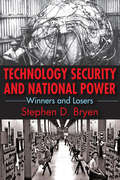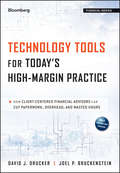- Table View
- List View
Technology Commercialization: Russian Challenges, American Lessons
by National Research CouncilThis collection of papers—by American and Russian specialists—addresses a variety of legal, regulatory, institutional, and financial issues that can promote or hinder technology commercialization. The book is the result of a series of workshops organized by the National Research Council with the Russian Academy of Sciences on commercialization of technologies, particularly those developed at research and educational institutions.Technology Commercialization concludes with a list of actions, programs, and policies which warrant further consideration as Russia tries to improve the success of technology commercialization. This book will be of interest to those concerned with small-business development in post-communist states, university technology management, and comparative technology commercialization.
Technology Convergence and System Divergence: Toyota and Uddevalla, Volvo
by Hikari Nohara Lars MedboThis book compares the production systems of Toyota, which has a belt conveyer, and Volvo’s factory in Uddevalla, Sweden, which doesn’t. Uddevalla has been famous as a human-centric work environment since the 1980s, but Toyota’s production style- lean production seems increasingly advantageous. Unlike what lean production is usually considered to imply, the authors finds many shared aspects of both systems, such as the meaningful assembly sequence, assembly-oriented parts grouping, kits for material supplies, buffer mechanisms, and the application of cognitive science. However, in their totality, the different production systems have different impacts on people and society. The differences come from different ways of judging human potential. In this regard, Uddevalla and Toyota can be productively contrasted, identifying the comparative advantages of automation and human labor.
Technology Cycles and U.S. Economic Policy in the Early 21st Century
by Nathan EdmonsonThe overarching theme of this volume is the cyclical nature of technological change, its impact on economic growth, and the limits of government intervention. Technological revolutions are infrequent; there were only three in all of the twentieth century. When they occur, their possibilities are often not immediately apparent. Technology revolutions induce capital investment, not just because they stimulate the need to acquire the new technology, but also because of the need to replace obsolete capacity and new infrastructure. While government has encouraged general economic progress by carrying out highly risky innovations unrelated to fostering economic growth, it seldom succeeds with specific efforts to foster growth. Recent examples of success include the Internet and the global positioning system (GPS), which trace their origins to defense-related research. In contrast, the countercyclical economic stimuli of 2007-2009 have achieved little in the way of general growth. The lack of data about the technology cycle makes formulating appropriate monetary and other policy countercyclical interventions difficult. A technology-founded upswing animated the American economy after 1990, and the -great recession- of 2007- 2009 reflected the waning of the investment boom that this revolution generated. Edmonson argues that the impact of technology revolutions on general economic growth has never received the attention it deserves. This volume will contribute much to debates on economic policy.
Technology Development Assistance for Agriculture: Putting research into use in low income countries (Routledge Explorations in Development Studies)
by Andrew Ward Norman Clark Andy Frost Ian MaudlinStemming from an 11-year DFID funded programme under its Renewable Natural Resources Research Strategy (RNRRS), Technology Development Assistance for Agriculture: Putting Research into Low Income Countries reviews part of this programme as a case study of a broader issue of technology development for Africa. Controversially, it critiques current international technology development assistance and focuses on the potential role of the private sector in agricultural technology development as well as providing insights for future cognate science policy and practice. The book focuses on the RIU "Best Bets" Africa sub-programme. This identified promising proposals to take existing agriculture research products and put these into use in ways that would benefit the poor in developing countries. The sum set aside for this was £5 million. The empirical sections of the book cover project selection, progress and programme management over a 2009-2012 period with special attention paid to lessons learned that may have implications for future cognate technology development assistance. This topical book gives direct evidence of meeting objectives and delivering real changes in technology development for Africa to postgraduate students, researchers, international bodies, NGOs, policy makers and government organisations working on natural resource management, technology development assistance, and low income country agriculture.
Technology Differences over Space and Time
by Francesco CaselliTechnology Differences over Space and Time looks at how countries use their productive resources--such as workers, skills, equipment and structures, and natural resources. Francesco Caselli develops methods to assess the efficiency with which productive inputs are used, and how these efficiencies vary across countries and over time. Caselli finds that richer countries use skilled workers relatively more efficiently than unskilled workers, and equipment and structures relatively more efficiently than natural resources. They also are relatively more efficient users of labor than of capital. Technological change tends to make countries particularly efficient at using skills and less efficient at using capital. Technical change also favors experienced workers. In order to interpret and understand these findings, Caselli presents a theory of technology choice. In this theory, firms pick technologies that make the most efficient use of the most abundant production factors when these factors are good substitutes for the less abundant factors. Firms pick technologies that make the most of less abundant factors when other suitable factors are not available for substitution. For example, rich countries, where skilled workers are abundant, use skilled workers efficiently, as these are good substitutes for unskilled workers. This flexible framework can be applied to other pairs of inputs, over time, and across countries.Technology Differences over Space and Time has significant implications not only for the theoretical understanding of development and technological innovation, but also for government formulation of industrial policy and multinationals making decisions about what to invest in and where to make those investments.
Technology Distribution Channels
by Julian DentUsing numerous real-life examples from global technology corporations, and with a foreword from Tim Curran the Chief Executive Officer of the Global Technology Distribution Council, this revised edition of Distribution Channels explores the chain that makes technology products and services available for market and explains how to make the most of each step of the process. By defining the role and significance of the various partners involved, including distributors, wholesalers and final-tier channel players, it provides a clear understanding of the entire go-to-market process, whilst also explaining channel partners' business models and how to engage with them for effective market access. Technology Distribution Channels covers both the tactical and strategic dimensions of channel economics as well as containing information on accessing and servicing markets and customers, controlling brands, integrating web and online channels, building the value proposition and creating differentiation. Comprehensive and clear, Technology Distribution Channels provides readers with the knowledge needed to improve their business model to ensure maximum market exposure and successful product delivery.
Technology Enabled Ergonomic Design: Select Proceedings of HWWE 2020 (Design Science and Innovation)
by Rauf Iqbal Vivek Khanzode N. K. Rana Aqueel A. ShahThis volume presents selected papers presented during the 18th International Conference on Humanizing Work and Work Environment (HWWE 2020). The book presents research findings on different areas of ergonomics for developing appropriate tools and work environment considering capabilities and limitations of working people for maximum effectiveness on their performance. The book is divided into several sections focusing on different ergonomic research activities currently being undertaken at both national and international levels. The volume will be of use to researchers, practitioners and students working in different fields of ergonomics.
Technology Entrepreneurship and Sustainable Development (Disaster Risk Reduction)
by Rajib Shaw Pradeep RayThis book discusses the need for entrepreneurship for sustainable development from the perspective of Asia, the fastest growing region in the world. The world is now witnessing a spectacular rise of technology entrepreneurship, involving mobile phones, artificial intelligence, geospatial information systems and social media. On the other hand, governments all over the world, particularly those in low and medium income countries, are facing severe resource constraints in developing the livelihood and well-being of citizens. Although many non-government organizations (NGOs) have worked on various development projects in a number of social sectors such as health, education, disabilities, poverty alleviation and environment, there is still substantial scope for technological innovation, including more efficient, effective and user-friendly solutions in different parts of the world. This book is organized into 2 parts and consists of 17 chapters. The first part explores education and well-being, and the second part discusses the climate, environment and disaster management.
Technology Entrepreneurship in Theory and Practice: Perspectives in Science and Engineering
by J. Mark Munoz Orestis TerzidisTechnology entrepreneurship refers to business activities that are based on new scientific insights and new technical developments. It describes the process by which enterprising teams and individuals convert new technical knowledge into products and services. It encompasses entrepreneurial pursuits in all fields of engineering and science where progress opens novel ways of creating value. Often these activities are based on intellectual property, although it may also make sense to consciously pursue an open technology strategy. Entrepreneurial activities in these domains lead to ventures with specific characteristics.Technology Entrepreneurship in Theory and Practice compiles the essential research knowledge about principles and practices in technology entrepreneurship. Systematically presenting theory and practice for entrepreneurs coming from an engineering or scientific background, the authors assemble a comprehensive overview of the subject and enhance it with their expert viewpoints. The book compiles and summarizes available knowledge and approaches to enable engineers and scientists to develop entrepreneurial initiatives.Technology Entrepreneurship in Theory and Practice will find an audience among technology entrepreneurs, engineers and scientists, entrepreneurship educators, executives, consultants, and policymakers worldwide.
Technology Entrepreneurship: Insights In New Technology-based Firms, Research Spin-offs And Corporate Environments (Fgf Studies In Small Business And Entrepreneurship Ser.)
by André Presse Orestis TerzidisThis collection of expert articles explores the development drivers of new technology-based firms and projects. It provides perspectives for an in-depth understanding of how technological inventions lead to the creation of new and sustainable companies or business units. The authors address methods and concepts that help technology-based start-ups and entrepreneurial projects successfully develop innovative products and services.
Technology Epiphanies: The Interplay between Technology-Push and Design-Driven Innovation
by Roberto VergantiIn many cases, radical innovations like the Nintendo Wii represent the intersection of design-driven innovation and a breakthrough in technology. The most popular game console on the market has redefined what playing with a game console means, but this redefinition was the result of an advance in technology that allowed the console to sense the speed and orientation of the controller. This chapter focuses on the interplay between the radical innovation of meanings that is at the center of design-driven innovation, and the radical innovation of technologies. This interplay is at the heart of some of the most successful products in many industries and can result in the complete reconfiguration of competition in a given industry. Three cases are considered: the Nintendo Wii, the Swatch, and the Applie iPod. This chapter was originally published as chapter 4 of "Design-Driven Innovation: Changing the Rules of Competition by Radically Innovating What Things Mean."
Technology Fears and Scapegoats: 40 Myths About Privacy, Jobs, AI, and Today’s Innovation Economy
by Robert D. Atkinson David MoschellaTechnologies and tech companies are routinely accused of creating many societal problems. This book exposes these charges as mostly myths, falsehoods, and exaggerations. Technology Fears and Scapegoats debunks 40 widespread myths about Big Tech, Big Data, AI, privacy, trust, polarization, automation, and similar fears, while exposing the scapegoating behind these complaints. The result is a balanced and positive view of the societal impact of technology thus far. The book takes readers through the steps and mindset necessary to restore the West’s belief in technological progress. Each individual chapter provides a cogent and often controversial rebuttal to a common tech accusation. The resulting text will inspire conversations among tech insiders, policymakers, and the general public alike.
Technology Innovation: Models, Dynamics, and Processes
by Angelo BonomiTechnology Innovation discusses the fundamental aspects of processes and structures of technology innovation. It offers a new perspective concerning fundamentals aspects not directly involved in the complex relations existing between technology and the socio-economic system. By considering technology and its innovation from a scientific point of view, the book presents a novel definition of technology as a set of physical, chemical and biological phenomena, producing an effect exploitable for human purposes. Expanding on the general model of technology innovation by linking the model of technology, based on a structure of technological operations, with the models of the structures for technology innovation, based on organization of fluxes of knowledge and capitals, the book considers various technological processes and the stages of the innovation process. Explains a novel definition of technology as a set of physical, chemical and biological phenomena producing an effect exploitable for human purposes Discusses technology innovation as result of structures organizing fluxes of knowledge and capitals Provides a technology model simulating the functioning of technology with its optimization Presents a technology innovation model explaining the territorial technology innovation process Offers a perspective on the evolution of technology in the frame of an industrial platform network The book is intended for academics, graduate students and technology developers who are involved in operations management and research, innovation and technology development.
Technology Innovations in K-12 Education
by John J-H Kim Roniesha Copeland Christine S. AnThis background note on technology innovations in education offers a market overview of the edtech sector and discusses trends, common challenges, and criticisms encountered in exploring edtech ventures. The note introduces the promise of educational technology as it directly affects classroom instruction and discusses the common growth drivers (e.g., school accountability, 21st century skills, and advanced technological innovations) and theories of change (e.g., personalization, access, and productivity) for edtech products and services. Furthermore, the note defines the conditions necessary for the success of innovations in educational technology in the classroom including adequate teacher training, funding, and technology infrastructure. The note also highlights several challenges, risks, and criticisms common to the edtech sector, such as the evolving role of teachers, issues of student privacy and data security, implementation challenges, and the limits of education technology's impact in the classroom.
Technology Integration to Business
by Seog-Chan Oh John T. YeeToday's global business environments drive companies to be more technology dependent, and to remain competitive, firms need to introduce or adopt a new technology to business. In order to achieve a successful integration with maximum return on investment, companies need a systematic approach that accommodates a comprehensive course of action of technology integration. Technology Integration to Business - Practical Methods and Case Studies suggests a business-driven holistic approach of technology integration that consists of several steps. First, companies should examine the current state, issues, benefits, and obstacles of technology integration in conjunction with their competitive business strategy and operational capability. Second, firms should investigate new, emerging business technologies as to how those technologies can contribute to improve the business. Third, with the technology integration needs identified, companies should complete preparatory tasks before actual implementation, such as, business process analysis, technology assessment, technology provider investigation, business case development, and cost-benefit analysis. Fourth, because the nature of technology integration project involves many stakeholders in global locations, firms should use effective project management knowledge from project initiation, through planning, execution, control, to close. Students will learn real-world technology integration processes in industry settings and become more prepared for industrial careers. Practitioners will find thorough procedures and methods that are useful in practice to improve business performance. Realistic examples for manufacturing, logistics, and supply chain management application domains give the reader practical implications for the methods presented.
Technology Law: Australian and International Perspectives
by Marcus Smith Gregor UrbasThe regulation of technology is an important and topical area of law, relevant to almost all aspects of society. Technology Law: Australian and International Perspectives presents a thorough exploration of the new legal challenges created by evolving technologies, from the use of facial recognition technology in criminal investigations to the rise and regulation of cryptocurrencies. A well-written and fascinating introduction to technology law in Australia and internationally, Technology Law provides thorough coverage of the theoretical perspectives, legislation, cases and developing issues where technology and the law interact. The text covers data protection and privacy, healthcare technology, criminal justice technology, commercial transactions, cybercrime, social media and intellectual property, and canvasses the future of technology and technology law. Written by leading experts in the field, Technology Law is an excellent resource for law students and legal professionals with an interest in the area.
Technology Management: Recognizing, evaluating and successfully using technologies (essentials)
by Josef GochermannIn this essential, Josef Gochermann provides a compendium of the essential elements of technology management and answers ten important questions on how to identify new technologies, properly evaluate relevant technologies, recognize opportunities and risks in time, and position yourself for technological success. He shows how to use technologies beneficially, make relevant technologies available at the right time, recognize the end of a technology's performance in time, and plan the use of technologies strategically and for the future.
Technology Meets Flowers: Unlocking the Circular and Digital Economy
by Eric van HeckWhy do the Dutch continue to play a central role in the global production, sales, and distribution of flowers? What are the origin and history of the bulb and flower industry in the Netherlands? How are Artificial Intelligence (AI), complex algorithms, and modern distribution systems ensuring that fresh flowers reach their destination on time? This very entertaining and informative book introduces readers to the global flower business, and highlights the surprising factors that helped the Dutch become global leaders on the flower markets. The book reveals the complexity of the flower markets in terms of their ability to produce, transport, and deliver fresh flowers on a global scale. In addition, it explores how information advantage is created by blending business with technology, from robotized glasshouses to the use of AI-driven algorithms for flower production and distribution. In closing, the book presents lessons learned regarding the circular and digital transformation of the high-speed flower business and markets in order to deliver sustainable value for customers.Combining the light beauty of flowers with the harsh language of the digital universe is a masterfully executed task in this book, organized as a bouquet of algorithms, data science, and digital platforms. Mandatory reading for all those interested in the flower business as well as for those who want to know more about the perfume emanating from digital systems. Eduardo Diniz Professor and Head of the Technology and Data Science Department, Escola de Administração de Empresas de São Paulo, Fundação Getulio Vargas, São Paulo, Brazil This unique book leads you through the bulb fields and auctions of the Netherlands, through history, logistics, auction design, and Internet technology, to draw lessons in business management from the study of flowers. With beautiful illustrations. A tour de force.John Kay Economist, Author of Radical Uncertainty and Greed is Dead, and Fellow, St. John’s College, University of Oxford, Oxford, United Kingdom If you want to understand the impact of information and technology on a fascinat- ing industry, this book is a must-read. The author explains in a highly intriguing way how innovations propelled the flower industry from the sixteenth century till today. Whether you are working in the flower industry, a business student, academic, or just intrigued by the business behind flowers, you will enjoy this book! Martin Mocker Professor of Information Systems, ESB Business School, Reutlingen University, Reutlingen, Germany. Research Affiliate, MIT Sloan Center for Information Systems Research, Cambridge, USA
Technology Offsets in International Defence Procurement (Routledge Studies in Innovation, Organizations and Technology)
by Kogila BalakrishnanTechnology offsets, a nonconventional international trade-financing tool, is used by governments (buyers) to obtain industrial and technological benefits from companies (sellers) as part of international procurement. Offsets deals involve billions of dollars and this practice exists in around 80 countries around the world. Though offsets is a popular practice in defence, it is increasingly gaining popularity in civil sectors. Offsets is often tainted by controversy and receives bad press. What then makes offsets popular? Governments claim that offsets delivers technology and knowledge transfer, skills in high technology sectors and employment, and offsets expands export opportunities through participation in OEM supply chains. For companies, offsets is mainly employed as a tool to obtain a competitive edge and win sales in international business. In the past, there have been mixed results of case studies on the impact of offsets successes and failures. Considering the mismanagement of globalisation, unfair trade agreements and current political and economic discontent, there is a stronger need for governments and companies to use vehicles such as offsets to create a relationship of trust and commitment for sustainable development. This book fills the gap in offsets and focuses on how to manage offsets more effectively by addressing issues of strategy, policy and implementation, technology management, governance and risk. Technology Offsets in International Defence Procurement is designed for those studying international procurement, international trade, international business, technology management, defence policy and industrial policy. This book will also be of interest to practitioners and policy makers in both government and industry.
Technology Rivalry Between the USA and China (Palgrave Studies in Global Security)
by Peter C.Y. ChowThis book addresses the geopolitics and geoeconomics of technological rivalry between the world’s two great powers: the USA and China. It focuses on the semiconductor industry, which, owing to its dual use in civilian and defence sectors, is critical to economic and national security interests. A diverse set of contributions from renowned scholars span wide-ranging topics to holistically analyze contemporary USA-China national security through a technological lens: the shifting trade and technology policy in the USA; the Chip-4 alliance as an industrial cartel; technology sanctions and the voice of high-tech industry in the USA; the race for digital sovereignty in the Gulf region and in Africa; Japan’s grand strategy vis-à-vis semiconductors; a critical assessment of China’s achievement on its self-sufficiency and effort in reducing its reliance on foreign supplies; the significance and the strategy of Taiwan’s semiconductor in the future, as well as how Taiwan can advance its national security through its status as a powerhouse of semiconductors; Korea’s semiconductor policy in response to international technology rivalry; India’s pursuit of semiconductors; and a close investigation of decoupling and hostility between the two great powers.
Technology Roadmapping and Development: A Quantitative Approach to the Management of Technology
by Olivier L. De WeckThis textbook explains Technology Roadmapping, in both its development and practice, and illustrates the underlying theory of, and empirical evidence for, technologic evolution over time afforded by this strategy. The book contains a rich set of examples and practical exercises from a wide array of domains in applied science and engineering such as transportation, energy, communications, and medicine. Professor de Weck gives a complete review of the principles, methods, and tools of technology management for organizations and technologically-enabled systems, including technology scouting, roadmapping, strategic planning, R&D project execution, intellectual property management, knowledge management, partnering and acquisition, technology transfer, innovation management, and financial technology valuation. Special topics also covered include Moore’s law, S-curves, the singularity and fundamental limits to technology. Ideal for university courses in engineering, management, and business programs, as well as self-study or online learning for professionals in a range of industries, readers of this book will learn how to develop and deploy comprehensive technology roadmaps and R&D portfolios on diverse topics of their choice.
Technology Run Amok: Crisis Management In The Digital Age
by Ian I. MitroffThe recent data controversy with Facebook highlights that the tech industry as a whole was utterly unprepared for the backlash it faced as a result of its business model of selling user data to third parties. Despite the predominant role that technology plays in all of our lives, the controversy also revealed that many tech companies are reactive, rather than proactive, in addressing crises. This book examines society's failure to manage technology and its resulting negative consequences. Mitroff argues that the "technological mindset" is responsible for society's unbridled obsession with technology and unless confronted, will cause one tech crisis after another. This trans-disciplinary text, edgy in its approach, will appeal to academics, students, and practitioners through its discussion of the modern technological crisis.
Technology Security and National Power: Winners and Losers
by Stephen D. BryenIn Technology Security and National Power, Stephen D. Bryen shows how the United States has squandered its technological leadership through unwise policies. Starting from biblical times, he shows how technology has either increased national power or led to military and political catastrophe. He goes on to show how the US has eroded its technological advantages, endangering its own security.The scope ofTechnology Security and National Power extends across 3,000 years of history, from an induced plague in Athens to chemical weapons at Ypres to an atomic bomb on Hiroshima to the nuclear balance of terror. It describes new weapons systems and stealth jets, cyber attacks on national infrastructure, the looting of America's Defense secrets, and much more. The core thesis is supported by unique insight and new documentation that reaches into today's conflicted world.More than a litany of recent failures and historical errors, this book is a wake-up call for political actors and government officials who seem unable to understand the threat. Technology Security and National Power proposes that the United States can again become a winner in today's globalized environment.
Technology Tools for Today's High-Margin Practice
by Joel P. Bruckenstein David J. DruckerRevolutionize your financial advisory practice with the latest cutting-edge toolsTired of spending more time with filing cabinets than with clients? Is overhead eating up your margins? In a new revised edition of the "bible" of practice management and technology for financial professionals, two leading financial planners, with some help from their friends*, deliver the knowledge advisors have been begging for. This book serves up a nontechnical trove of technology, clever workarounds, and procedural efficiencies tailored to help financial advisors in private practice move toward today's virtual office. The authors show you how to drastically reduce the paperwork in your office, slash overhead, and find anything you need in seconds using the latest software.This revised edition includes new information on SaaS and cloud computing, software integrations, mobile devices/apps, social media tools, portfolio accounting and outsourcing, collaborative tools, digital signatures, workflow management, marketing technology and much more.Perfect for successful practices seeking greater efficiencies and healthier profit marginsThe authors are well-known financial advisors, each with more than 30 years of experience in financial servicesAddresses the evolution of the virtual office and its impact on advisory firms If you're looking for new systems and efficiencies to transform and streamline your private practice, look no further than Technology Tools for Today's High-Margin Practice. *Chapter 1 Selecting the Right CRM System, Davis D. JanowskiChapter 2 The Future of Financial Planning Software, Bob CurtisChapter 3 The Future of Financial Planning Software and the New Client-Advisor Relationship, Linda StrachanChapter 4 Portfolio Management Software, Mike KellyChapter 5 Achieving Growth and Profitability with Technology Integration, Jon PatulloChapter 6 How the World Wide Web Impacts the Financial Advisor, Bart WisniowskiChapter 7 Managing Your Online Presence, Marie SwiftChapter 8 Client Portals and Collaboration, Bill WinterbergChapter 9 The Cloud, J. D. BruceChapter 10 Digital Signature Technology, Dan SkilesChapter 11 Innovative Software and Technologies Implemented at One of the United States' Leading Advisory Firms, Louis P. StanasolovichChapter 12 Virtual Staff Sparks Growth, Profitability, and Scalability, Jennifer GoldmanChapter 13 ROI--The Holy Grail of the Technology Purchase Decision, Timothy D. WelshChapter 14 Building an Efficient Workflow Management System, David L. Lawrence
Technology Transfer Between the US, China and Taiwan: Moving Knowledge (Routledge Research on Taiwan Series)
by Douglas B. Fuller Murray A. RubinsteinExamining the flow of technical knowledge between the US, Taiwan and Mainland China over the last sixty-five years, this book shows that the technical knowledge that has moved between these states is vast and varied. It includes the invention and production of industrial goods, as well as knowledge of the patterns of corporate organization and management. Indeed, this diversity is reflected in the process itself, which is driven both by returning expatriates with knowledge acquired overseas and by successful government intervention in acquiring technology from multinational firms. Technology Transfer Between the US, China and Taiwan engages with the evolving debates on the merits, importance and feasibility of technology transfer in the process of economic development globally, and uses the example of Taiwan to show that multinational corporations can indeed play a positive role in economic development. Further, it reveals the underlying tension between international cooperation and nationalism which inevitably accompanies international exchanges, as well as the delicate balancing act required between knowledge acquisition and dangerous levels of dependency, and the beneficial role of the US in East Asia’s technological development. With contributors from disciplines ranging from history, geography, urban planning, sociology, political science and electrical engineering, this multi-disciplinary book will be of great interest to students and scholars working across a broad range of subjects including Taiwan studies, Chinese studies, economics, business studies and development studies.
